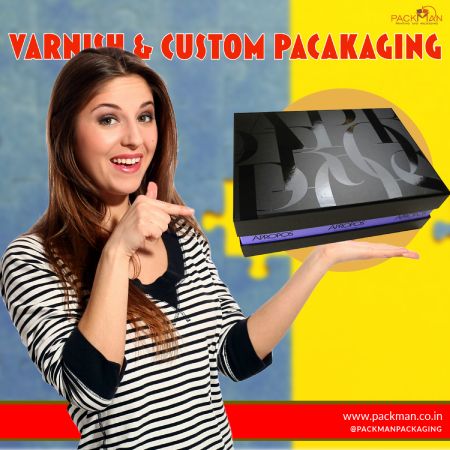Shares Packman Packaging India’s Top Custom Corrugated Box Manufacturer
In today’s fiercely competitive business landscape, where every brand is vying for attention, packaging emerges as a crucial factor that can set your products apart from the rest. Custom packaging plays a vital role in protecting products and building a unique brand identity. It allows companies to create packaging that reflects their values and message, going beyond standard solutions. The elegance of packaging lies in the finer details, like glossy varnishes, which enhance the product’s presentation and leave a lasting impression on discerning customers.
Packman Packaging delves deep into the topic to help the readers understand the use of varnish in custom packaging.
Varnish—What is it?
Varnish is a popular finishing technique used extensively in the packaging and printing industry. It refers to the application of liquid coating on the surface of printed materials for protection and to increase its visual appeal.
Purpose
1. Aesthetics: Whether it is a gloss matte or satin varnish, it enhances the visual appeal of the product thus creating a memorable unboxing experience.
2. Protection: Custom packaging often faces a rough journey from the manufacturer to the customer’s hands. Varnish adds a layer of protection to your packaging, preventing scratches, scuffs, and moisture damage and ensuring their longevity. This is particularly important if your products are delicate or valuable.
3. Sustainability: In today’s environmentally conscious world, eco-friendly packaging is a growing trend. Varnish can be used with water-based and UV-cured options, which are more environmentally friendly than traditional solvent-based varnishes.
4. Various options: Varnish offers endless possibilities for customization. Whether you want to create a vintage, rustic look or a modern, sleek appearance, varnish can adapt to your creative vision.
Types of varnishes used
In order to make the right choice, customers must know the different types of varnishes used today.
1. Gloss Varnish:
It is a popular choice for packaging and printing due to its high shine and reflective properties. Its popularity stems from its ability to impart a glossy, reflective sheen, enhancing color vibrancy and providing a professional, attention-grabbing finish. Additionally, it offers superb protection against moisture, abrasion, and fading, making it suitable for various materials such as paperboard, plastic, and metal. This versatility makes it an excellent choice for applications like food and beverage packaging, as well as cosmetic and electronic packaging. The glossy finish makes text reading difficult.
2. Matte Varnish:
This, on the other hand, offers a non-reflective, velvety finish. It creates a soft, muted effect that reduces glare and minimizes the appearance of surface imperfections. It is often used to achieve a sophisticated, elegant look, particularly on premium packaging and high-end printed materials. It provides a tactile experience and is less prone to fingerprints and smudges compared to gloss varnish. It is a perfect packaging choice for luxury items, electronics, and cosmetics.
3. Satin Varnish:
Satin varnish, also known as velvet or suede varnish, offers a subtle sheen and smooth finish, falling between gloss and matte varnishes. It’s versatile for packaging and printing with a refined appearance, balancing reflectivity. It protects against scratches and scuffs, popular in the cosmetics, fragrance, and fashion industries, enhancing brand exclusivity.
4. Strike-through Matte Varnish:
Strike-through matte is a technique where matte and gloss varnishes are applied selectively to a printed item. Matte varnish covers most areas, except where a glossy effect is desired. This creates a contrast, allowing the gloss to stand out while giving the rest a softer appearance. It effectively distinguishes packaging elements.
The varnishing process involves printing the design, drying the ink, applying varnish for protection and aesthetics, ensuring even coverage, curing for durability, and creating a protective barrier. This meticulous process enhances the packaging material’s appearance and safeguards its contents from environmental damage.
Conclusion
In a world where first impression matters, don’t hesitate to consult packaging experts who can help you pick the right varnish.





